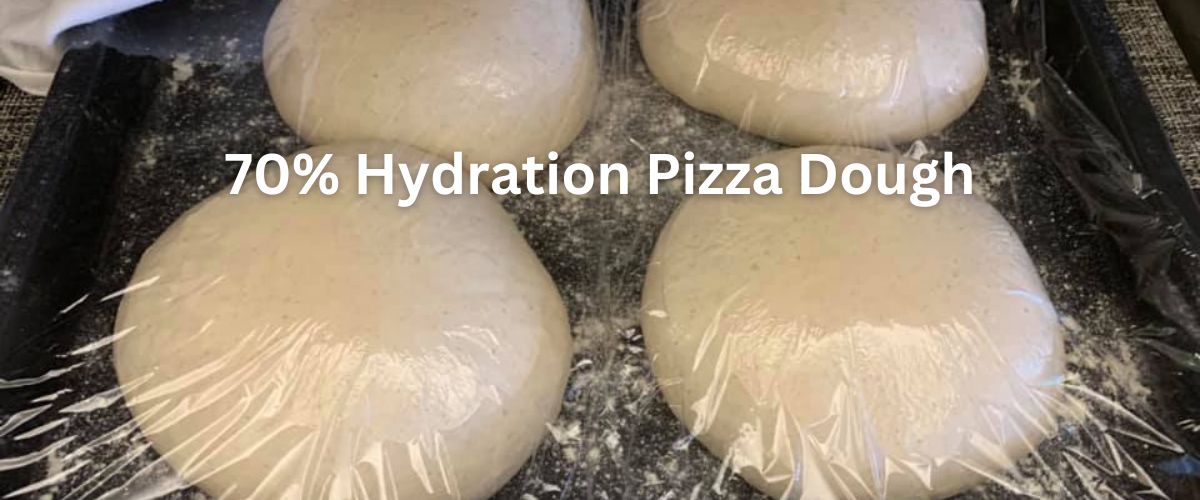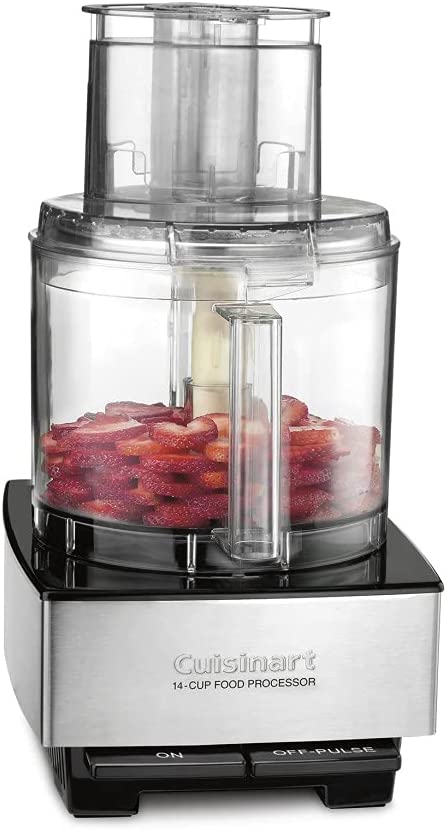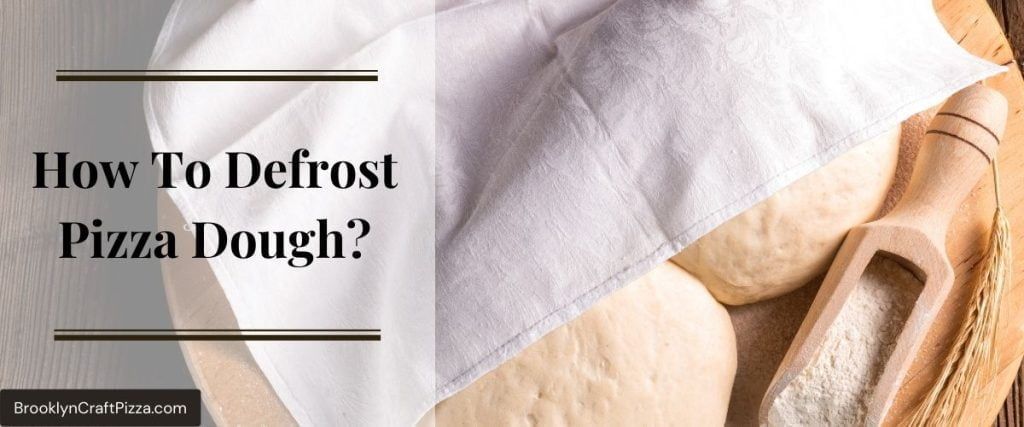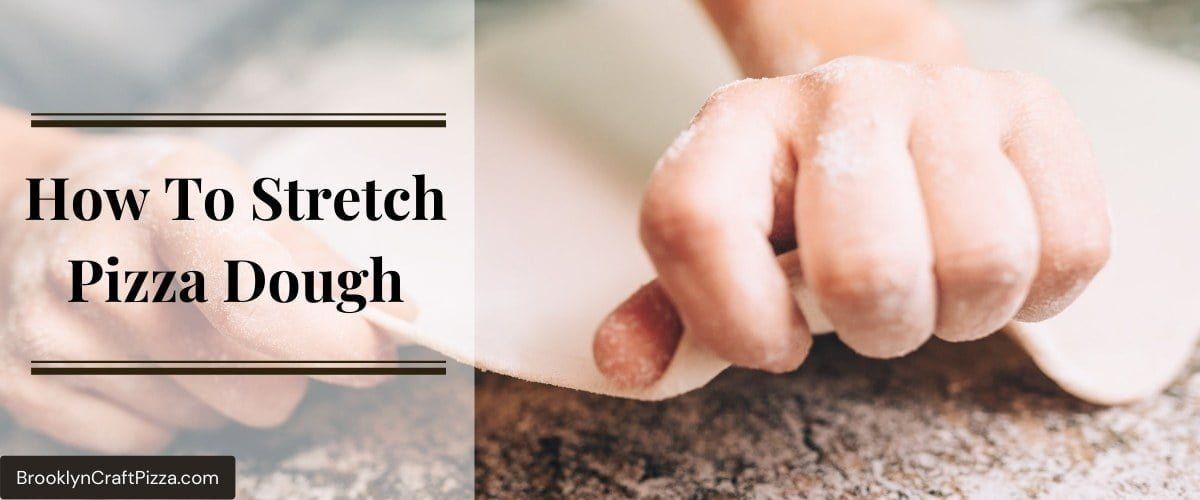
70% Hydration Pizza Dough – Say Bye To Dry Crut
Do you like pizza? Do you like it enough to eat it even if you’re not very hungry? There’s a way to make your pizza eating experience even more enjoyable, and that’s by adding some hydration to the dough.
Do you ever get pizza cravings, but don’t want all the carbs?

This 70% hydration pizza dough is for you! It’s still got that delicious crust flavor but with only 70% of the carbs. Plus, it’s really easy to make – all you need is a food processor and a baking dish. Give it a try today!
In this blog post, we’ll be sharing a recipe for 70% hydration pizza dough that is sure to tantalize your taste buds. So what are you waiting for? Get ready to roll up your sleeves and get cooking!
What is Pizza Dough Hydration?
Hydration is the ratio of water to flour in your dough. The higher the percentage of water, the more hydrated your dough will be. A lower percentage of water means a less hydrated, or drier, dough.
Pizza dough hydration is the amount of water that is added to the flour to make the dough. The more water that is added, the higher the hydration percentage will be.
For example, if you add 1 cup of water to 2 cups of flour, your dough will be at 50% hydration.
The ideal pizza dough hydration percentage is between 60-65%. This range creates a dough that is pliable and easy to work with, but not so wet that it’s sticky and still maintaining a crispy crust once baked. However, some people prefer a dough with a higher or lower hydration percentage. It all comes down to personal preference!
Pizza Dough Hydration Level
The hydration level of your pizza dough will affect the texture, flavor, and overall quality of your pizza.
- A higher hydration level will produce a dough that is softer, more flavorful, and less likely to crack when rolled out thin.
- A lower hydration level will result in a dough that is firmer, less flavorful, and more likely to crack when rolled out thin.

How To Calculate Pizza Dough Hydration
If you use 1 cup of water and 2 cups of flour, your hydration percentage would be 50%. So, how to know exactly the hydration percentage of pizza dough?
💡 To calculate the hydration level of your pizza dough, you’ll need a kitchen scale. Weigh the flour and water separately, simply divide the total amount of water used by the total amount of flour.
For example, if you have 1 cup (120 grams) of flour and j cup (60 grams) of water, your dough would be at 50% hydration.
Keep in mind that different types of flour will absorb different amounts of water. For example, bread flour will absorb more water than all-purpose flour. So if you’re using bread flour, you may need to adjust the amount of water you use accordingly.
Absorption and Recommended Hydration for Different Types of Pizza Flour
| Flour type | Recommended hydration | Absorption |
|---|---|---|
| All-purpose | 60% | 58-62% |
| Bread flour | 65% | 62-64% |
| Semolina | 70% | 68-72% |
| 00 flour | 60-70% | 56-66% |
| 100% whole wheat | 60-65% | 54-58% |
Now that you know all about pizza dough hydration, it’s time to get cooking!
The Importance Of Hydration When Making Pizza Dough
Whether you’re making pizza dough from scratch or using a store-bought mix, it’s important to pay attention to the hydration level.
Hydration is key when it comes to making pizza dough. The amount of water in the dough will affect the texture, flavor, and overall quality of your pizza.
🔸 A higher hydration level will produce a dough that is softer, more flavorful, and less likely to crack when rolled out thin.
🔸 A lower hydration level will result in a dough that is firmer, less flavorful, and more likely to crack when rolled out thin.
If the dough is too dry, it will be difficult to work with and may crack when rolled out thin. It will also be less flavorful and more likely to produce a crust that is hard and crunchy.
On the other hand, if the dough is too wet, it will be sticky and may be difficult to shape. It will also be more likely to produce a crust that is soggy or chewy.
There are a few things to keep in mind when it comes to hydration levels in pizza dough.
First, different types of flour will absorb different amounts of water. For example, bread flour will absorb more water than all-purpose flour. So if you’re using bread flour, you may need to adjust the amount of water you use accordingly.
Another thing to keep in mind is that the ideal pizza dough hydration level is between 60-65%. This range creates a dough that is pliable and easy to work with, but not so wet that it’s sticky and still maintains a crispy crust once baked.
However, some people prefer a dough with a higher or lower hydration percentage. It all comes down to personal preference!
How Pizza Dough Hydration Affects The Dough
Pizza Dough Hydration Affects the Taste
The hydration level of your pizza dough will affect the flavor in a few different ways.
- A higher hydration level will produce a dough that is more flavorful because the water activates the enzymes in the flour which release more of the wheat’s natural sugars.
- A lower hydration level will result in a dough that is less flavorful because less of the wheat’s natural sugars are released.
A higher hydration level will produce a dough that is more flavorful, while a lower hydration level will result in a dough that is less flavorful.
Pizza Dough Hydration Affects the Texture
The hydration level of your dough will also affect the texture. A higher hydration level will produce a dough that is softer and more pliable, while a lower hydration level will result in a firmer, less pliable dough.
Pizza Dough Hydration Affects the Overall Quality
The hydration level of your dough will also affect the overall quality of your pizza. A higher hydration level will produce a dough that is less likely to crack when rolled out thin, while a lower hydration level will result in a dough that is more likely to crack when rolled out thin.
The Best Pizza Dough Hydration Percentage
The best pizza dough hydration percentage is between 60-65%. This range creates a dough that is pliable and easy to work with, but not so wet that it’s sticky and still maintains a crispy crust once baked.
However, some people prefer a dough with a higher or lower hydration percentage. It all comes down to personal preference!
If you’re looking for a delicious pizza dough recipe that is sure to please, look no further than this 70% hydration pizza dough recipe. This dough is the perfect balance of flavor and texture, and it’s easy to make. So what are you waiting for? Give it a try today!
The Final Verdict
So, what’s the final verdict? Is 70% hydration pizza dough the best option for you? Only you can decide! Try out this recipe and see for yourself how delicious it is. We think you’ll be pleasantly surprised.
Factors That Will Affect Hydration Levels In Pizza Dough
There are a few factors that can affect the hydration levels in pizza dough.
✅ First, the type of flour you use will make a difference. Bread flour will absorb more water than all-purpose flour, so if you’re using bread flour, you may need to adjust the amount of water you use accordingly.
✅ Another factor that can affect hydration levels is the amount of time you allow the dough to rest.
If you allow the dough to rest for a longer period of time, it will absorb more moisture from the air and become more hydrated.
Conversely, if you allow the dough to rest for a shorter period of time, it will not have enough time to absorb moisture from the air and will be less hydrated.
✅ Finally, the temperature and humidity of your kitchen will also affect the hydration levels in pizza dough.
If it’s a very humid day, the dough will absorb more moisture from the air and become more hydrated. Conversely, if it’s a dry day, the dough will not absorb as much moisture from the air and will be less hydrated.
Keep these factors in mind when you’re making pizza dough so that you can adjust the amount of water you use accordingly.
The Perfect Pizza Dough Hydration Percentage
So what’s the perfect pizza dough hydration percentage? The answer may surprise you! While most people think that 60-65% is the ideal range, some experts believe that 70% is actually the perfect hydration level for pizza dough.
A dough with a hydration level of 70% will be softer and more pliable than a dough with a lower hydration level. It will also be more flavorful and less likely to crack when rolled out thin. If you’re looking for a delicious, easy-to-work-with pizza dough, aim for a hydration level of 70%.
Of course, it’s ultimately up to you to decide what hydration level you prefer. Try out this recipe and see for yourself how delicious it is. We think you’ll be pleasantly surprised!
How To Make 70% Hydration Pizza Dough
What is 70% Hydration Pizza Dough?
A 70% hydration pizza dough is a dough that contains 70% water. This type of dough is softer and more pliable than a lower hydration dough, and it’s also more flavorful and less likely to crack when rolled out thin.
If you’re looking for a delicious, easy-to-work-with pizza dough, aim for a hydration level of 70%. 🥰

Not sure how to calculate the hydration level of your pizza dough? No problem! Just weigh the flour and water separately, then divide the total amount of water used by the total amount of flour.
For example, if you use 1 cup of water and 2 cups of flour, your hydration percentage would be 50%.
Keep in mind that different types of flour will absorb different amounts of water. For example, bread flour will absorb more water than all-purpose flour. So if you’re using bread flour, you may need to adjust the amount of water you use accordingly.
How To Make 70% Hydration Pizza Dough Step By Step
Now that you know all about 70% hydration pizza dough, it’s time to get down to business and make some pizza dough! This recipe makes enough dough for two 12-inch pizzas. We think you’ll be pleasantly surprised!
Ingredients:
- 2 cups (240 grams) bread flour
- 1 cup (240 grams) filtered or distilled water
- 1 teaspoon (4 grams) active dry yeast
- 1 teaspoon (6 grams) sugar
- 1 teaspoon (1.5 grams) salt
- 1 tablespoon (15 grams) olive oil
Instructions:
1. In the bowl of a food processor, combine the bread flour, water, yeast, sugar, salt, and olive oil. Pulse until the dough comes together in a ball. If the dough is too dry, add additional water 1 tablespoon at a time. If the dough is too wet, add additional flour 1 tablespoon at a time.
2. Transfer the dough to a lightly floured surface and knead for 5 minutes.
3. Place the dough in a greased bowl, cover with plastic wrap or a damp towel, and let rise in a warm place for 30 minutes to 1 hour.
4. Preheat your oven to 500 degrees Fahrenheit (250 degrees Celsius).
5. Divide the dough into two equal pieces and shape into balls. Place on a lightly floured surface and let rest for 10 minutes.
6. Roll out the dough to your desired thickness. If the dough is too elastic and springs back, let it rest for 5-10 minutes before trying again.
7. Transfer the dough to a greased pizza pan or baking sheet and top with your favorite sauce and toppings.
8. Bake for 10-12 minutes, or until the crust is golden brown and the cheese is bubbly.
9. Enjoy!
Tips For Getting The Best Results With 70% Hydration Pizza Dough
Now that you know how to make 70% hydration pizza dough, it’s time to talk about how to get the best results. Here are a few tips and tricks to help you out:
🔸 If your dough is too sticky, add additional flour 1 tablespoon at a time until it’s easy to work with.
🔸 If your dough is too dry, add additional water 1 tablespoon at a time until it comes together in a ball.
🔸 If your dough is too elastic and springs back when you try to roll it out, let it rest for 5-10 minutes before trying again. This will give the gluten time to relax so that it’s easier to work with.
🔸 To get a crispy crust, preheat your oven to 500 degrees Fahrenheit (250 degrees Celsius) and bake the pizza for 10-12 minutes, or until the crust is golden brown and the cheese is bubbly.
🔸 If you want a softer crust, preheat your oven to 425 degrees Fahrenheit (220 degrees Celsius) and bake the pizza for 12-14 minutes, or until the crust is golden brown and the cheese is bubbly.
We hope you enjoy this 70% hydration pizza dough recipe! Happy cooking!
Recipes For Delicious Pizzas Made With 70% Hydration Pizza Dough
Now that you know how to make 70% hydration pizza dough, it’s time to put it to good use! Here are a few of our favorite recipes for delicious pizzas made with this type of dough:
– Classic Margherita Pizza: This classic pizza is made with a 70% hydration pizza dough, tomatoes, mozzarella cheese, and fresh basil leaves.
– Hawaiian Pizza: This tasty pizza is made with ham, pineapple, mozzarella cheese, and your favorite pizza sauce.
– Pepperoni Pizza: This classic favorite is made with a 70% hydration pizza dough, tomato sauce, pepperoni slices, and mozzarella cheese.
– Vegetarian Pizza: This healthy pizza is made with a 70% hydration pizza dough, tomato sauce, mushrooms, onions, peppers, and mozzarella cheese.
– BBQ Chicken Pizza: This flavorful pizza is made with a 70% hydration pizza dough, BBQ sauce, chicken, onions, and mozzarella cheese.
– Buffalo Chicken Pizza: This spicy pizza is made with a 70% hydration pizza dough, buffalo sauce, chicken, onions, and mozzarella cheese.
We hope you enjoy these recipes! Happy cooking!
Pizza Dough Hydration Tips
If your dough is too dry, it will be difficult to work with and will result in a crust that is tough and not very flavorful. Add a little bit of water until the dough is soft and pliable, but not sticky.
If your dough is too wet, it will be sticky and difficult to work with. It will also result in a crust that is soggy and won’t hold up to toppings very well. Add a little bit of flour until the dough is soft and pliable, but not sticky.
The type of flour you use can also affect the hydration level of your dough. For example, bread flour will absorb more water than all-purpose flour. So if you’re using bread flour, you may need to adjust the amount of water you use accordingly.
Finally, keep in mind that different types of pizza dough will require different amounts of hydration. For example, a Neapolitan pizza dough will be much wetter than a New York-style dough.
So if you’re following a specific recipe, make sure to use the correct amount of water for the dough you’re making.
The Best Flour for Pizza Dough
When it comes to pizza dough, you’ll want to use a flour that has a high protein content. This will help to create a dough that is strong and elastic, so it can be stretched thin without breaking. A higher protein flour will also produce a crispier crust once baked.
Some of the best flours for pizza dough are bread flour, all-purpose flour, and semolina flour. If you’re looking for a gluten-free option, you can try using a gluten-free all-purpose flour or rice flour.
Just keep in mind that the dough may not be as easy to work with and the crust may not be as crispy.
FAQs
What does 70% hydration mean in pizza dough?
What is the difference between 60% and 70% hydration pizza dough?
A 60% hydration dough will be less sticky and easier to work with, while a 70% hydration dough will be more sticky and difficult to work with.
The finished crusts will also be different – a 60% hydration crust will be crispier, while a 70% hydration crust will be chewier.
What is the best hydration for pizza dough?
A higher hydration level (70-80%) will result in a dough that is more sticky and difficult to work with, but will produce a crust that is crisp and chewy. A lower hydration level (60-70%) will result in a dough that is less sticky and easier to work with, but will produce a crust that is crispier.
Ultimately, it’s up to you to decide what type of dough and crust you prefer.
What is the best hydration percentage for pizza dough?
A higher hydration level (70-80%) will result in a dough that is more sticky and difficult to work with, but will produce a crust that is crisp and chewy. A lower hydration level (60-70%) will result in a dough that is less sticky and easier to work with, but will produce a crust that is crispier.
🔸 Best Hydration for Neapolitan Pizza Dough Percentage: 75-80%
🔸 Best Hydration for New York Style Pizza Dough Percentage: 60-65%
🔸 Best Hydration for Chicago Deep Dish Pizza Dough Percentage: 68-72%
For a more in-depth look at hydration levels in pizza dough, check out this article from The Kitchn.
Ultimately, it’s up to you to decide what type of dough and crust you prefer.
Why is pizza dough hydration important?
A higher hydration level will result in a dough that is more sticky and difficult to work with, but will produce a crust that is crisp and chewy. A lower hydration level will result in a dough that is less sticky and easier to work with, but will produce a crust that is crispier.
Ultimately, it’s up to you to decide what type of dough and crust you prefer.
Is higher hydration pizza dough better?
A higher hydration level (70-80%) will result in a dough that is more sticky and difficult to work with, but will produce a crust that is crisp and chewy. A lower hydration level (60-70%) will result in a dough that is less sticky and easier to work with, but will produce a crust that is crispier.
Ultimately, it’s up to you to decide what type of dough and crust you prefer.
What flour is best for pizza dough?
🔸 Bread flour has a higher protein content than all-purpose flour, which gives it a higher gluten content. This results in a dough that is stronger and more elastic, which is ideal for pizza dough.
🔸 All-purpose flour can be used for pizza dough, but it will not produce as strong or elastic of a dough as bread flour.
🔸 Semolina flour is made from durum wheat and has a high gluten content. It is often used in pasta doughs, but can also be used for pizza dough. Semolina flour will produce a pizza dough that is strong and elastic.
What happens if you put too much water in pizza dough?
Ultimately, it’s up to you to decide what type of dough and crust you prefer.
Final Thoughts
The hydration level you use for your pizza dough will depend on the type of dough you’re making and your personal preferences.
A higher hydration level (70-80%) will result in a dough that is more sticky and difficult to work with, but will produce a crust that is crisp and chewy. A lower hydration level (60-70%) will result in a dough that is less sticky and easier to work with, but will produce a crust that is crispier.
Ultimately, it’s up to you to decide what type of dough and crust you prefer.
We’ve seen that a high level of hydration is key for pizza dough. Our 70% hydration recipe gives you a crust that is both soft and flavorful. Thanks for following along with our experiments, and we hope you give this recipe a try!
Hopefully, you enjoyed this post on 70% hydration pizza dough. Please feel free to share this post with your friends and family, and be sure to check back often for more recipes from our kitchen.
If you have any questions or comments, please feel free to share them below. And be sure to check out our other posts for more baking tips and tricks!



